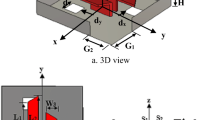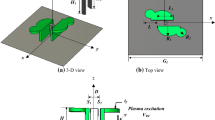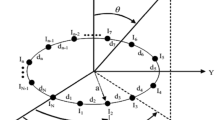Abstract
In this paper, an approach for the synthesis of desired pattern in 4D antenna linear and planar arrays is proposed, taking into account practical element models. The element of the array is a plasma ME-dipole operating in the band 1.3–3.65 GHz with circular polarization characteristics of 13.3%, from 2.2 GHz to 2.52 GHz with 95% radiation efficiency. A linear arrangement of 16-element spaced by 0.65λ connected with 16 RF-switches with periodic switching frequency of 100 MHz is investigated using different switching time sequences. A planar array consists of 8 × 8 plasma ME-dipoles are designed for different beam shapes. The approach is based on the combination of the particle optimization technique (PSO) and the full-wave simulation using the finite integral technique (FIT). The time sequences are optimized by the PSO algorithm and the patterns at the fundamental frequency and sideband frequencies are synthesized and exported automatically to the array analyzes using the FIT technique. The time-domain excitations can be decomposed into a Fourier series in frequency-domain, thus obtaining equivalent complex excitation distributions at different frequencies. This paper introduces the applicability of planar array in the beam-shaping. Chebyshev, Taylor and binomial planar array are presented. This paper focuses on the pattern synthesis of 4D planar arrays taking into account the mutual coupling between the elements.












Similar content being viewed by others
Availability of data and material
There are no supplementary materials, and the data is available upon reasonable request.
Code availability
The program is available upon request
References
Haykin, S. S., & Moher, M. (2011). Modern wireless communications. Pearson Education India.
Xiang, W., Zheng, K., & Shen, X. S. (2016). 5G mobile communications. Springer.
Nguyen, A. H., Cho, J.-H., Bae, H.-J., & Sung, H.-K. (2020). Side-lobe level reduction of an optical phased array using amplitude and phase modulation of array elements based on optically injection-locked semiconductor lasers. Photonics, 7(1), 20.
Haupt, R. L. (2010). Antenna arrays: A computational approach. John Wiley & Sons.
Allard, R. J., Werner, D. H., & Werner, P. L. (2003). Radiation pattern synthesis for arrays of conformal antennas mounted on arbitrarily-shaped three-dimensional platforms using genetic algorithms. IEEE transactions on antennas and propagation, 51(5), 1054–1062.
Hakkarainen, A., Werner, J., Dandekar, K. R., & Valkama, M. (2013). Widely-linear beamforming and RF impairment suppression in massive antenna arrays. Journal of Communications and Networks, 15(4), 383–397.
Li, M., Zhang, Z., Tang, M.-C., Yi, Da., & Ziolkowski, R. W. (2020). Compact series-fed microstrip patch arrays excited with Dolph-chebyshev distributions realized with slow wave transmission line feed networks. IEEE Transactions on Antennas and Propagation, 68(12), 7905–7915.
Rao, N. A., Kanapala, S., & Sekhar, M. (2019). Wideband circular polarized binomial antenna array for L-band radar. In G. Panda, S. Satapathy, B. Biswal, & R. Bansal (Eds.), Microelectronics, electromagnetics and telecommunications (pp. 279–287). Springer.
Sarker, M. A., Hossain, M. S., & Masud, M. S. (2016). Robust beamforming synthesis technique for low side lobe level using Taylor excited antenna array. In: 2016 2nd International Conference on Electrical, Computer & Telecommunication Engineering (ICECTE), pp. 1–4. IEEE.
Cen, L., Zhu Liang, Y., Ser, W., & Cen, W. (2011). Linear aperiodic array synthesis using an improved genetic algorithm. IEEE Transactions on Antennas and Propagation, 60(2), 895–902.
Marini, F., & Walczak, B. (2015). Particle swarm optimization (PSO). A tutorial. Chemometrics and Intelligent Laboratory Systems, 149, 153–165.
Bogdan, G., Yashchyshyn, Y., & Jarzynka, M. (2016). Time-modulated antenna array with lossless switching network. IEEE Antennas and Wireless Propag. Lett., 15, 1827–1830.
He, C., Wang, L., Chen, J., & Jin, R. (2018). Time-modulated arrays: A four-dimensional antenna array controlled by switches. Journal of Communications and Information Networks, 3(1), 1–14.
Chakraborty, A., Ram, G., & Mandal, D. (2021). Multibeam steered pattern synthesis in time-modulated antenna array with controlled harmonic radiation. International Journal of RF and Microwave Computer‐Aided Engineering, 31(5), e22597.
Zainud-Deen, A. S., Malhat, H. A., Badway, M. M., & Rihan, M. (2021). Full-wave simulation of time-modulated parabolic linear array using the method of moments. In: 38th National Radio Science Conference (NRSC), Egypt, B4.
Tennant, A., & Chambers, B. (2007). A two-element time-modulated array with direction-finding properties. IEEE Antennas Wirelss Propag. Lett., 6, 64–65.
Maneiro-Catoira, R., Bregains, J., Garcia-Naya, J. A., & Castedo, L. (2020). Time-modulated array beamforming with periodic stair-step pulses. Signal Processing, 166, 107247.
Jozef, M., Yashchyshyn, Y., & Bogdan. G. (2019). 4D antennas design and technology–the state of the art. In: 2019 IEEE MTT-S International Wireless Symposium (IWS), pp. 1–3. IEEE.
Qun, W.B. (2016). Design of magneto-electric dipole antennas, Ph.D. thesis, Dept. of Elect. Eng. City, University of Hong Kong.
Feng, B., Hong, W., Li, S., An, W., & Yin, S. (2013). A dual-wideband double-layer magneto electric dipole antenna with a modified horned reflector for 2G/3G/LTE applications. International Journal of Antennas and Propagation, 2013, 1–9.
Malhat, H. A., & Zainud-Deen, S. H. (2020). Plasma-based artificial magnetic conductor for polarization reconfigurable dielectric resonator antenna. Plasmonics, 15(5), 1913–1924.
Li, M., & Luk, K. (2015). Wideband magneto electric dipole antennas with dual polarization and circular polarization. IEEE Antennas and Propag. Magazine, 57(1), 110–119.
Anderson, T. (2011). Plasma antennas. Artech House.
Zainud-Deen, S. H., Malhat, H. A., & Shabayek, N. A. (2020). Reconfigurable RCS reduction from curved structures using plasma based FSS. Plasmonics, 15(12), 1–10.
Zainud-Deen, S. H., El-shalaby, N. A., Malhat, H. A., & Gaber, S. M. (2019). Reconfigurable multi-turns planar plasma helical antenna. Plasmonics, 14(6), 1831–1837.
Zainud-Deen, S. H., & Malhat, H. A. (2019). Electronic beam switching of circularly polarized plasma magneto-electric dipole array with multiple beams. Plasmonics, 14(4), 881–890.
Baklanov, Y. V. (1966). Chebyshev distribution of currents for a plane array of radiators. Radio Engineering and Electronics Physics, 11, 640–642.
Tseng, F. I., & Cheng, D. K. (1968). Optimum scannable planar arrays with an invariant sidelobe level. Proceedings of the IEEE, 56, 1771–1778.
Funding
There is No funds, grants, or other support was received to conduit this study.
Author information
Authors and Affiliations
Contributions
All the authors contribute equally in this paper.
Corresponding author
Ethics declarations
Conflict of interest
The authors have no conflicts of interest or competing interests to declare that are relevant to the content of this article.
Ethical approval
There is no ethical approval is required. 'Not applicable'.
Consent to participate
Informed consent was obtained from all individual participants included in the study. 'Not applicable'.
Consent for publication
Authors are responsible for correctness of the statements provided in the manuscript.
Additional information
Publisher's Note
Springer Nature remains neutral with regard to jurisdictional claims in published maps and institutional affiliations.
Rights and permissions
About this article
Cite this article
Malhat, H.A.EA., Zainud-Deen, A.S. Beam-shaping technique for plasma magneto-electric dipole planar array based on time-modulation and particle swarm optimization. Wireless Netw 28, 3001–3018 (2022). https://doi.org/10.1007/s11276-022-03001-0
Accepted:
Published:
Issue Date:
DOI: https://doi.org/10.1007/s11276-022-03001-0




